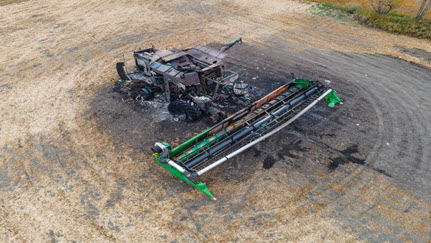Protecting yourself from combine and field fires

Harvesting equipment like combines are a major investment on the farm. These modern machines are powerful and complex, often carrying over 25 gallons of hydraulic oil and 300 gallons of fuel. Combine that with the dry, dusty residue accumulating from hours of threshing, and you’ve got a serious fire risk on your hands. Don’t worry though, here are 3 essential tips to keep your combine and fields safe from fires:
1. Create a fire plan
- Equip with fire extinguishers: Keep a charged 10-pound ABC fire extinguisher in the cab of the combine and at least one additional 20-pound ABC fire extinguisher mounted somewhere on the combine. Additional fire extinguishers should be carried on grain cart tractors and trucks.
- Carry extra water and tools: Consider carrying extra water and shovels, particularly in dry conditions. A UTV sprayer full of water, a leaf blower, and a round-nose shovel can be great assets in a field fire.
- Prepare for field fires: If the fire spreads to unharvested areas, the most effective tool may be a tillage implement if you have the capacity to have one standing by.
- List emergency contacts: Make a list of 911 addresses for fields and always carry a charged cell phone.
- Train your crew: Ensure everyone on the harvesting crew knows and understands what to do in the event of a fire.
2. Start each day with a clean machine
- Use a leaf blower: A portable leaf blower can be a great tool in the field to blow the loose chaff from the engine compartment, exhaust system, and bearing housings.
- Clean windows and mirrors: Clean the windows and mirrors so that the operator has the best chance to see the entire machine.
- Check fluid levels: With the engine compartment clean, it is easier to check fluid levels, radiator screens, and air filters.
- Remove debris: Remove any wrapped stalks or chaff from sprockets, chains, bearings, or belts.
3. Monitor the machine throughout the day
- Watch for rising engine temps: Rising engine temperatures signal that the machine is not able to adequately cool itself. Windy conditions can blow residue back into the machine, plugging screens, depositing residue, or causing air intake problems.
- Use a thermal imager: A handheld thermal imager from FLIR can be useful in a midday walk-around to identify overheating components or belts and bearings with excessive friction.
In case of a combine fire, follow these safety tips:
- Stop the machine and lower the head to the ground if possible.
- Shut off the machine to stop all hydraulic and fuel pumps.
- Exit the cab, call 911, and report the fire.
- Deploy your fire extinguisher(s).
- Reconnect with 911 to update them of any changes if needed.
- Do not re-enter the cab until the fire department gives the “all clear.”
Michel, Joshua. “Fire Prevention Tips During Harvest.” Iowa State University Extension and Outreach. Accessed September 30, 2024.
https://crops.extension.iastate.edu/blog/joshua-michel/fire-prevention-tips-during-harvest.
Oregon State University Extension Service. Preventing and Responding to Combine Fires. EM 9326. Accessed September 30, 2024.
https://extension.oregonstate.edu/catalog/pub/em-9326-preventing-responding-combine-fires.

 >
>

 >
>
 >
>